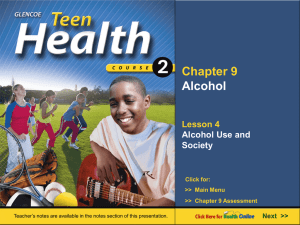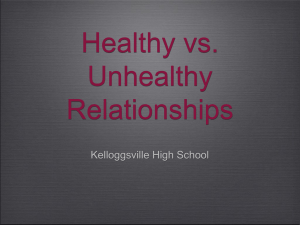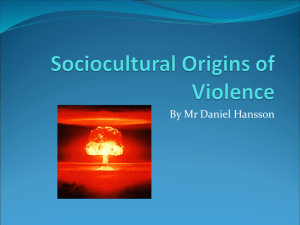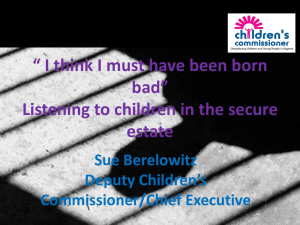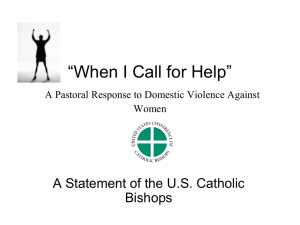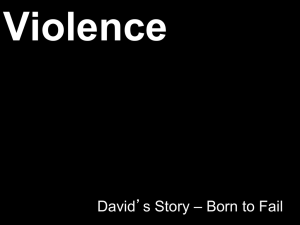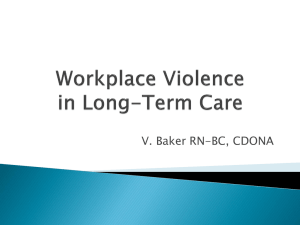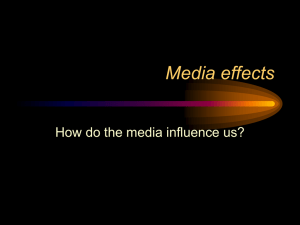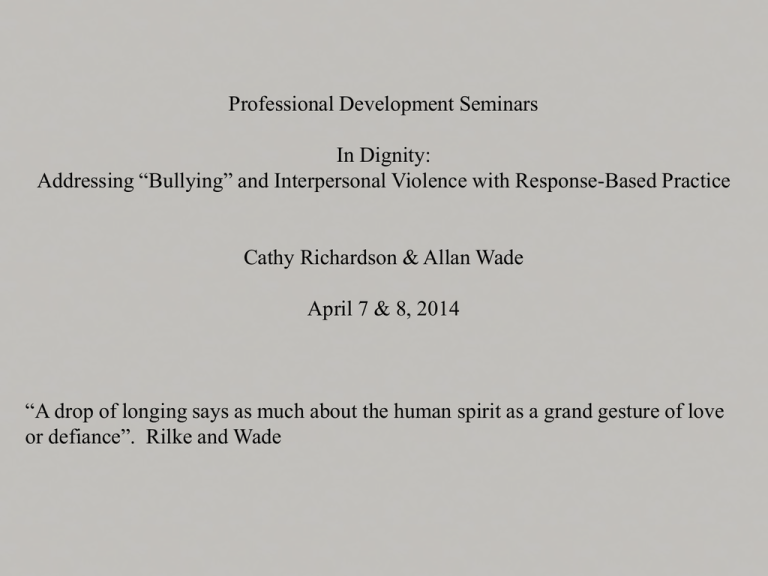
Professional Development Seminars
In Dignity:
Addressing “Bullying” and Interpersonal Violence with Response-Based Practice
Cathy Richardson & Allan Wade
April 7 & 8, 2014
“A drop of longing says as much about the human spirit as a grand gesture of love
or defiance”. Rilke and Wade
Centre for Response-Based Practice
www.responsebasedpractice.com
• Individual, family, group counseling
• Supervision, consultation with staff in diverse organizations
• Research
Violence and language: Professional and public discourse
Social responses
Family law and domestic violence
• Consulting
Communities developing socially just responses to violence
Legal counsel: Review/evaluation of “custody and access” reports
Expert Panel on Family Law and Domestic Violence
• Projects
“Islands of Safety”: Child protection model/intervention
“Together for Justice”: RCMP and Indigenous Yukon women
Charlene: “Residential school”
Joe: “Armed robbery and racism”
Dignity and Resistance
Understanding Responses to Violence and Oppression
Karin (15)
Carolina: Can I ask in those situations when you were scared and felt like
something was wrong, did you feel like you could do something then?
Karin: No, that was the thing. I was so little and had so many feelings.
Sometimes I could say to daddy, please dad please be quiet, don’t be
bothered by what mummy says. I played along with him for a while and
played along with him and thought this will help and pretended that
mummy was the one who was sick. So I said that if you could only be
quiet don’t be bothered by what she is saying you know she is wrong
(pause) so be quiet and go outside and be angry.
Eric (8) is describing a scene where his father was acting aggressively.
E: He said bad things. I was sad.
T: I can understand that.
E: I hid in the bathroom.
T: You did?
E: And Daddy came and knocked, bash, bash, bash.
T: On the door?
E: Yes. And I hid in the bathroom.
T: That was clever of you. You were brave to run and hide.
E: Thank you! Thank you very much.
Lotta (9)
Margareta: Have things been okay at home?
Lotta: Yes, but then yesterday mum and dad started fighting about
something, but I just closed my ears.
Margareta: What do you do when you close your ears? Do you use
something to put in your ears?
Lotta: No, I try not to care or try to talk to them about something else.
Then I listen to really loud music so they’ll get angry at me instead.
Dignity:
“A Social Emotion”
Vaclav Havel
Something of that early self-awareness probably stayed with me: My
bourgeois background . . . awakened (or, more exactly, strengthened) within
me something like a social emotion, an antagonism toward undeserved
privileges, toward unjust social barriers, toward any kind of so-called higher
standing predetermined by birth or by anything else, toward any humiliation
of human dignity. (p. 7)
I've always understood my mission to be to speak the truth . . . to warn
rather than hand out prescriptions for change (p. 8) . . . to nourish the
plurality of social association from below. (p. 21).
Nelson Mandela
I learned my lesson one day from an unruly donkey. We had been taking turns
climbing up and down on its back and when my chance came I jumped on and
the donkey bolted into a nearby thorn bush. It bent its head, trying to unseat
me, which it did, but not before the thorns had pricked and scratched my face,
embarrassing me in front of my friends. Like the people of the East, Africans
have a highly developed sense of dignity, or what the Chinese call "face". I had
lost face among my friends. Even though it was a donkey that unseated me, I
learned that to humiliate another person is to make him suffer an unnecessarily
cruel fate. Even as a boy, I defeated my opponents without dishonouring them.
(1994, p. 11-12)
What is dignity?
• Respect/worth: Self-respect & respect from others.
- “self-esteem/worth” and “social esteem/worth”
- inclusion, competence
• Self-sovereignty/control: Autonomy, freedom, identity
- in extreme situations (prisoners, patients)
• Physical and psychological integrity (wholeness)
• The ability to care for others, especially loved ones
• A sense of efficacy, agency, ability to “make a difference”
• An inherent quality of the person in spiritual and social justice terms
Dignity and Social Life
• Social life is organized largely around the according and preserving of
dignity (face).
• Affronts to dignity create immediate social “problems” that participants
work to repair.
• Humiliation requires “just redress”. Failure to supply “just redress” leaves
an open social wound.
• Dignity is central to individual and collective well-being.
Micro-practices of dignity in social interaction
•
•
•
•
•
Courtesy, politeness, embedded commands
Deference to social station (e.g., elders, leaders/roles)
Responses to failed jokes
Micro-politics of the accidental fart
Advice-design and receipt
Dignity and Resistance
• For many victims, humiliation is the primary affront, the most lasting and
painful injury
“The bruises go away but you never forget what he said to you.”
“He got my body but he didn’t get me.”
• Responses and resistance are often oriented to preserving, asserting dignity
• The violence may be only the first in a series of indignities delivered through
social responses
• Our central task, whatever else we do, is to acknowledge the dignity to the
victim
Counselling session with young Maori man (17)
He was sleeping in a garage sleepout when the Police forced the door open (with a
police dog) and arrested him in front of his girlfriend at 2:00 in the morning.
C. You seem upset.
B. Crying – “They shouldn’t have done this to me”. I can’t sleep at night
thinking about it. Last night my grandfather (his guardian) asked me to sleep with
him, but it didn’t help.
C. Can we talk about what happened?
B. They treated me like shit. They dragged me out onto the street in my
underpants. They handcuffed me – my arms behind my back. They stood me
there for over an hour. The cuffs cut my wrists. When they dragged me out onto
the street, my knees and legs got cut on something and bled a lot.
C. Wow, that sounds really bad.
B. They need to apologise to me. They need to come to school and stand in front
of the whole school in their underpants and say sorry.
C. Can you tell me more about what happened?
B. They took away my mana. In the old days, my family would have killed them
and eaten them to get our mana back.
C. Can you tell me more about the old ways?
B. I am a good person. You can ask anyone. My grandparents are spiritual
people. Our Iwi are spiritual people.
C. Did this spirituality help you the other night?
B. Yes. I know this about us. I did not resist. I fainted once, but for the rest of
the time I stood there.
C. Did you talk to them?
B. Yes, but they did not listen. They just want me to say that I had done it.
C. What was that?
B. That I had stolen an i-pod from a car earlier that night. They asked me if I had
an i-pod and I told them I did but it was mine bought with money I had earned.
C. That was a good answer. What else did you say?
B. There were five constables there and lots of cars. I asked to talk to a Sargent,
but they just laughed at me.
C. Good on you for asking that.
B. Yes, I know that I needed to talk to someone in authority.
C. What else happened?
B. Well, I asked if I could put my pants on after about 40minutes. My
girlfriend brought my pants out and they took my handcuffs off. I thought they
would leave them off, but they just put them on in front and then made me put
my pants on with cuffed hands. It was really difficult and I felt humiliated.
C. But you mangaged it?
B. Yes, I got my pants on.
C. Well done you. It was great that you managed that.
B. Finally a Police car came with a witness in it, who told them they had the
wrong person. The cop on the street just did a throat cut movement and they
took the cuffs off and left. It seems the dogs had picked up the wrong smell and
tracked me by mistake.
C. What did you do?
B. I went to my grandparents who had arrived. My grandfather would have
collapsed if he had seen me handcuffed. I wanted to make sure he was OK
and that he could see I was OK.
C. That’s wonderful that, and given all that had happened to you, you still
thought and cared for your grandparents.
Pause
C. What would be helpful to you now? Would having a Kaumatua pray
with you help?
B. Yes. Yes that would be good. I could get Papa Hemi to do Karakia with
me. He knows about the old ways. He knows about healing.
Amanda Todd (2012)
Hello,
I’ve decided to tell you about my never ending story,
In 7th grade I would go with my friends on webcam,
Meet and talk to new people,
Then I got called stunning, beautiful, perfect, etc.,
Then wanted me to flash,
So I did…A year later…
I got a msg on facebook,
From him…Don’t know how he knew me…
It said…If you don’t put on a show for me I will show ur boobs
He knew my address, school, relatives, friends, family names,
Christmas break….
Knock at my door at 4 am…
It was the police…My photo was sent to everyone.
Then I got really sick and got…
Anxiety, major depression and panic disorder
I then moved and got into Drugs and Alcohol
My anxiety got worse…I couldn’t go out
A year past and the guy came back with my new
List of friends and school, but made a new facebook page
My boobs were his profile pic…
Cried every night, lost all my friends and respect
People had for me…again…
Then nobody liked me
Name calling, judged…
I can never get that photo back
It’s out there forever
I started cutting…
I promised myself never again…
Didn’t have any friends and I sat at lunch alone
Everything was better even though I still sat alone
At lunch in the library everyday
[I got with a guy who I was nice to me]
He hooked up with me….
I thought he liked me…
1 week later I get a text get out of your school…
His girlfriend and 15 others came including himself…
The girl and 2 others just said look around nobody likes you
In front of my new school (50) people
A guy than yelled just punch her already
So she did…she threw me to the ground and punched me several times
Kids filmed it. I was all alone and left on the ground.
I felt like a joke in this world. I thought nobody deserves this
I was alone…I lied and said it was my fault and my idea
I didn’t want him getting hurt, I thought he really liked me
But he just wanted the sex. Someone yelled punch her already
Teachers ran over but I just went and laid in a ditch and my dad found me
I wanted to die so bad…When he brought me home I drank bleach
It killed me inside and I thought I was gonna actually die
Ambulance came and brought me to the hospital and flushed me
After I got home all I saw was on facebook:
-She deserved it. Did you wash the mud out of your hair?-I hope she’s dead.
6 months has gone by. People are posting pictures of bleach, Clorox and ditches
Tagging me…I was doing a lot better too…they said…
She should try a different bleach. I hope she dies this time and isn’t so stupid
They said I hope she sees this and kills herself…
Why do I get this? I messed up but why follow me
I left your guys city…I’m constantly crying now
Everyday I think why am I still here?
My anxiety is horrible now…I never went out this summer
All from my past…life’s never getting better…I can’t go to school
Meet or be with people…constantly cutting. I’m really depressed.
I’m on anti depressants now and counselling and a month ago this summer
I overdosed…In hospital for 2 days…
I’m stuck…what’s left of me now…nothing stops
I have nobody
I need someone
My name is Amanda Todd
Decisive and Dignified Responses to Social Aggression by Children/Youth
Safety First:
• Stop the aggression
• The effectiveness of all interventions increases with swift and decisive
social responses.
Obtain Accurate Descriptions:
• Who is doing what to whom?
• Avoid mutualizing.
Improving Social Responses to Children/Youth
• Decisive and dignified interventions to create safety
• Response-Based Practice with aggressors and targeted children/youth.
Individual, family, group of youth, aggressor and target
• Cultural inclusion: Elders involved on regular basis. Roles, genealogy,
histories of resistance.
• Whole class solution-focused approach: Sue Young
With whole classes and with teaching staffs
• Restorative approaches
What is being restored? Is targeted youth safe, free of coercion?
Is unilateral nature preserved? Is a clear analysis involved?
• “Bystander” approach
How do “bystanders” already intervene?
• Addressing prejudice, hatred
Support for pro-LGBIT, anti-racists, ability-rights, activism
Sue Young, England
A “whole class” solution-focused approach to (not “anti-bullying”) but “promoting
safe and friendly schools”.
Describing the preferred future. Imagine you visit a school tomorrow . . . What
would tell you it was a friendly, supportive and safe community, a 10?
Each person in turn, shares one idea each
● The first thing I would notice that would tell me this is a friendly school is..
.
● Another thing I would see in a supportive school is...
Make a list. Keep going!
sue@young.karoo.co.uk
Working with class groups
● Outcomes for projects report schools as a whole, rather than
classes
● Some evidence to suggest this is misleading
● The difference in bullying may be as large between
classes in schools as between schools
● Recent meta-analysis (Wong) suggested that class work is
more important than whole school policies
SF anti-bullying discussions
● Describing the preferred future:
● How do they want the class to be?
● Recognising the successful past: What have you done well today?
● Appreciating existing strengths:
● Complimenting, appreciating each other
● Doing more of what works:
● If you are even better next time, what will be
different?
The government in England recommends all schools have an
“Anti-Bullying Week”
● How about “Friendship Week” instead!
In pairs . . . make a list of ideas, that you could do next week...
the smallest things you could do, to promote a friendly
atmosphere in class/school.
Anti-bullying
● Not just a preventive activity
● Focus on how the school community wants to be ...
articulate it, live it and teach it.
● A proactive friendly and supportive ethos
reduces bullying in schools, not strategies to solve it !
Assumptions:
● School staff know best how they want their school to be.
● School staff have all the skills and strengths they need to
make their school more like they want it to be.
● Outside experts need to get a lot better at appreciating what
they do and helping them do it !
Social Responses
Complete and accurate descriptions are the best foundation for developing
effective responses to social problems. This is especially true in cases of
violence because of the danger and deception that is so often involved.
Social Responses to Victims and Offenders
How family, friends, professionals, and larger society (media, police, child
protection, courts) respond when violence is disclosed.
A majority of victims report receiving negative social responses
Examples: What does “positive” and “negative” mean?
Family
Friends
Police
Court
Child protection
Marginalized, disadvantaged people are more likely to receive negative social
responses: LGBTQ, Aboriginal, Refugee, Disabled
The quality of social responses may be the best single predictor of the level of
victim distress
Victims’ Responses to Social Responses
Victims respond physically (epigenetically, hormonally), emotionally,
mentally, socially, spiritually – to positive and negative social responses
Victims who receive POSITIVE social responses:
- tend to recover more quickly and fully
- are more likely to work with authorities
- are more likely to report violence in future
Victims who receive NEGATIVE social responses:
- less likely to cooperate with authorities
- less likely to disclose violence again
- more likely to receive diagnosis of mental disorder
Response-Based Contextual Analysis
Allan Wade (2014
Social
Material
Conditions
Responses
to Social
Responses
Situation
Interaction
Social
Responses
Offender
Actions
Victim
Responses
Resistance
Violence is deliberate (with rare exceptions)
Offenders anticipate and work to suppress victim resistance
• Bank robberies
• Purse snatching
• Biker hangouts
• Child violation
• Bullying, social cruelty
• Workplace harassment
Offenders exercise control and strategy even in “explosive” attacks
In domestic and family violence, there is typically a history of skilled and
sensitive and respectful behaviour before the offender begins to abuse.
Offenders work to manage social responses
Implications/Observations
• Youth already know how to be respectful, non-violent
• O’Connor: Men are more involved in reflecting on their actions and
responsibility than is usually presumed
• Todd: Boys/men speak two languages, the language of effects and the
language of responses
• The question is not, “Why are men/people violent?”. The better question is:
“In what circumstances are people more likely to choose violence?”
• Youth experiencing violence elsewhere are more likely to commit aggression
at school, in community.
Children/youth who use aggression are often seen as:
• “out of control”
• lacking in skill
• disordered
• victims
Instead, what if children/youth already possess awareness and skill?
Find evidence of deliberation, awareness, skill, control:
Home, sports, friendships, work, class
In the strategies of aggression
In desisting aggression, some of the time
With safe adults providing positive social responses
Once safety is established:
Enquire about experience with aggression, loss – at home, etc.
Focus on their responses and resistance
Identify pre-existing capacities
From “The Cycle Theory of Violence”
Generally, she realizes that his battering behaviour is out of control and that
he will not respond to reason.
(Walker, 1979, p. 62)
The batterer ends up not understanding what happened. His rage is so great
that it blinds his control over his behaviour. He starts out wanting to teach
the woman a lesson, not intending to inflict any particular injury on her, and
stops when he feels she has learned her lesson.
(Walker, 1979, p. 60)
The batterer, spurred on by her apparent passive acceptance of his abusive
behaviour, does not try to control himself.
(Walker, 1979, p. 57)
During the first stage, minor verbal abuse, the woman tries to calm the abuser and
often changes her lifestyle to avoid angering the man. This usually sets a precedent
of submissiveness by the women building the gateway to future abuse. The second
stage consists of an “uncontrollable discharge of tensions that have been built up
during phase one. Ciraco, 2001, p. 169)
Both the batterer and the battered woman fear they cannot survive alone, and so
continue to maintain a bizarre symbiotic relationship [and] cannot extricate
themselves. (Walker, 179, p. 43)
“Self-correction is better than correction by others”.
Nick Todd (2000)
Finding Control, Deliberation: Example 1
A man gave a long and agitated description of how his wife “pushed his buttons”
and how he “lost it”. In the middle of the description, he said that he broke
through her patio door with a hammer and “headed for her bedroom . . . just
seeing red”.
T: “So, just a second, can I just ask you . . . after you broke the window, what did
you do with the hammer?”
C: “Oh, I put it down. You don’t think I’m going into her bedroom with a
hammer in my hand. I’m not frikkin’ stupid”.
T: “Okay . . . well . . . that was very deliberate of you . . . to put down the
hammer. How did you manage that?”
Reflexive Frame Breaks: Problematizing Responsibility
C: She accepted this guy's phone number and I got really pissed off. Like, that's
wrong, it’s just really wrong. And she never told me about kissing this guy until
we moved out here. And it was like, you know, I have a very hard time trusting
women. I have yet to have a woman that's . . . and . . . it’s my own fault, maybe
its because of me . . . . But, you know, I've yet to have a woman remain loyal.
T: What's got you thinking, maybe I had a hand in this, maybe it’s my own fault?
C: Because . . . I feel I push them away. I force them away.
Problematizing Responsibility cont’d
T: How?
C: By being angry, being jealous. I'm a very jealous person.
T: So you've been thinking over this problem, where the trust doesn't seem to be
there, like, "I'm wondering if my anger . . . .”
C: Yeah, I think it's got a lot to do with it. I push them away. I pushed Sue away
because I can't just let them just go and do what they want. I have a hard time. I
want . . . you know, I don't want to be a push-over . . . but I don't want to be . . . as
aggressive as I have been.
Alternatives to Responsibilization: Example 1
A 15 year old boy in a residential program for “acting-out youth” “trashes the
room”, throwing furniture. A chair breaks a window. Later, the boy is willing to
take responsibility for breaking furniture and for dealing with his anger
inappropriately but insists that breaking the window was “an accident”.
Responsibilizing:
“Don’t you think that since you threw the chair you should take
responsibility for the window breaking?”
Alternative:
“So if you had broken the window on purpose that would not be good. Why
do you think that breaking things on purpose is not good?”
From the language of effects . . .
. . . to the language of responses.
Kick a rock or kick a person
• If you kick a rock . . .
• If you kick a person . . .
The “effects” and “responses” game
• A house cat
• An armed robbery
• A child’s experience of his parents’ divorce
• Rain causes umbrellas
• Umbrellas are effects/impacts/consequences of rain
• Sexualized abuse causes depression, despair
• Depression, despair is an effect/impact of sexualized abuse
Negative bias in the language of effects/impacts
• A negative cause (spouse assault, rape) can produce only negative effects.
We cannot say . . .
• Child sexualized abuse causes alert and effective parenting
• Alert and effective parenting is one of the leading effects or impacts of
child sexualized abuse
But we can say . . .
• Many people respond to sexualized abuse by becoming alert and effective
parents
How the language of effects conceals responses/resistance
• A friend . . .
• A woman who is attacked by her partner . . .
Response or effect?
“When I was 15 or so I was touched up by the optometrist, and its meant
I’ve never actually worn my glasses.”
Example from Liz Kelly (1988)
Surviving Sexual Violence
Accurate Descriptions and People in the Object Position
The language of effects/impacts cannot reveal who a person “is”; what they stand
for, who they cherish, what they detest, what they know and believe, how they see
their place in the world.
• Bob punched Sue.
• Jeremy was beaten until he was unconscious and left on the side of the road.
• The colonial government implemented law to allow theft of Indigenous lands.
• Ever since he could remember, Harold saw his Dad beating up his Mom,
putting her down, telling her she was “a piece of shit”.
Accurate Descriptions and People in the Subject Position
By learning how people respond, even in part, we begin to see their sense of
purpose and can obtain a more complete and accurate picture of events. The
response is the first effort to retain dignity and manage adversity.
• Bob punched Sue. Sue backed up slowly and closed the door to the bedroom
where the children were sleeping.
• Jeremy was beaten until he was unconscious and left on the side of the road.
Witnesses said he refused to stay down after intervening to stop a man slapping
a child.
• The colonial government implemented law to allow theft of Indigenous lands.
Indigenous people resisted the theft of their land through rebellion, letters,
petitions, protests, and more recently through appeal to the supreme court.
• Ever since he could remember, Harold saw his Dad beating up his Mom,
putting her down, telling her she was “a piece of shit”. Harold would bring his
Mom tea and a warm cloth and stay home from school with a stomach ache.
From effects to responses: Pairs or trios
Part 1: One person shares a time they experienced some form of unfairness
or injustice – nothing too raw or serious.
The second person asks questions to track the effects or impacts of that
event on the person:
The physical, emotional, mental, social effects.
The effects immediately and over the long term.
The third person keeps track of grammar and verbs.
Part 2: Using the same event, and beginning again from the beginning, the
second person asks how the person responded, overtly and covertly.
The third person keeps track of grammar and verbs.
Purpose: To experience the difference between engaging in effects-based
and response-based conversations, linguistically, socially, subjectively.
Language
Violence and Language:
Accurate Descriptions are Key to Effective Social Responses
“Language is . . . inseparable from ourselves as a community of human beings
with a specific form and character, a specific history, a specific relationship to
the world”. (Ngugi wa Thiong’o, 1986, pp. 15-16)
"A sense of the unique, specific and concrete circumstances of any situation is
the first indispensable step to solving the problems posed by that situation.”
(David Trimble, former Co-President of Ireland, 1998).
“All prescriptions about what to do imply descriptions about what is [already]
the case”. (Terry Eagleton, 2003, p. 87)
“Shit happens and how we talk about it matters.”
(Biff Sneed, Canadian Margin for Practical Realism)
But . . .
“Telling a professional that the language they use is wrong is a bit like
telling a grandparent that their new grandbaby is ugly.”
Sheri van Spronsen
Unlike babies, some descriptions are quite ugly:
“comfort women”
“settlement”
“abusive relationships”
“sex with a minor”
“unwanted intercourse”
Violence is Unilateral
• Violence consists of actions by one person against the will and well being of
another
• Mutual Acts vs. Unilateral Acts
• Hand-shaking vs hand-shaking
• Boxing
• Kissing
• Mutual acts imply and entail consent, co-action, co-agency, joint activity
• “If you hit someone on the head with a frying pan, you don’t call it
cooking.” (Anonymous Canadian genius)
Unilateral Language and Property Crimes
• Car theft is not “auto sharing”
• Bank robbery is not a “financial transaction”
Similarly . . .
• Wife-assault is not a “dispute” or “argument” or “abusive relationship”
• Child rape is not “sex with a child” or “child prostitution”
Woman Charged with Illegal Money Sharing
Wellington
Police arrested Sue Maloney yesterday for allegedly illegally sharing money
in the amount of $500,000.00, from the All Black Bank of N.Z. The bank
clerk, who agreed to the transaction when a gun was pointed at his face, was
unhurt. “I’m just happy the incident is over”, said Kerry Lightly, who has
participated in three similar transactions in recent years. “I don’t know why
these customers choose me”, he said. The bank manager, Mr. R.E. Tentive,
stressed that Mr. Lightly would receive “psychiatric help to address his
anxiety and ensure he no longer attracts greedy customers.”
Ms. Maloney was released on condition that she have no contact with bank
clerks and attends specialized treatment at the Mt. Eden Centre for
“wealthophelia”. A DSM-IX congenital disorder linked to a bio-financial
imbalance in the brain, “wealthophelia” is more common in first degree
biological relatives living near the ocean. It is characterized by the
compulsive pursuit of illegally obtained financial independence.
Recommended tx: Sedation by reality television.
Unilateral
Mutual
• forced his mouth on hers
• kiss
• wife-assault, beating
• abusive relationships
• forced vaginal penetration
• sex, intercourse
• beating, attack, assault
• fight, conflict, argument
• workplace bullying
• personality conflict
• invasion, genocide
• war, conflict, historical
relationship problem
• international child rape
• sex tourist, sex with minors
• cyber-bullying
• extortion, blackmail
Colonial Discourse
Colonization has always been based upon the existence of need and
dependency. Not all people are suitable for being colonized; only those who
feel this need are suitable. In almost all cases where Europeans have
founded colonies . . . we can say that they were expected, and even desired
in the unconscious of their subjects.
(Mannoni, 1947, cited in Macey)
Wife-Assault
The partners’ characteristics hold them together. . . . As abused partners
adapt and become more compliant . . . the partners’ characteristics make
them increasingly dependent on one another. After prolonged abuse they
develop complementary characteristics: aggressive/passive,
demanding/compliant, blaming/accepting guilt.
(Anonymous Family Violence Project, 2008)
From Clear to Obscure
Active:
Bob hit Sue.
Simple passive:
Sue was hit by Bob.
Agentless passive:
Sue was hit.
Nominalization:
An assault took place.
Mutualizing:
There was a domestic dispute.
Mutualizing Interventions
• workplace abuse
~
conflict resolution
• child/spouse abuse
~
mediation
• bullying
~
non-violent communication
• genocide
~
reconciliation
• administrative domination
~
partnership, collaboration
Yukon Territorial Strategy:
Bullying Behaviours among School-Age Children
2014
Page 1
Simply put, bullying is a relationship problem. Contrary to popular belief,
bullying is a learned behaviour that is not a necessary part of growing up.
Page 7 - 8
Children who are bullied by others are generally perceived as „different‟ in
some way from their peers. They may appear or behave differently from
their peers, come from a different socio- economic status, or have higher or
lower academic achievement. They also may simply be in the wrong place at
the wrong time. Other factors that increase a child’s risk for being bullied
include, but are not limited to, sexual orientation and gender identity,
race/religion/culture, and presence of a diagnosed “disability‟.
Occasionally, children are bullied by others because they intentionally
provoke negative reactions from peers and/or find some benefit in assuming
a „victim‟ role (e.g., means of obtaining attention). These children are in
need of adult support to help address underlying issues (e.g. self-esteem).
Page 9
Bullying can have a serious impact on the overall development of a child.
There are numerous short and long-term effects of bullying on both the
individual carrying out the bullying behaviour, and the individual who is
being bullied.
For children who are bullied, impacts may include feelings of distress,
confusion, anxiety, anger, fear, insecurity, as well as physical injury, poor
concentration, loss of self-esteem, problematic school attendance, decline in
academic performance, psychosomatic symptoms (e.g., headaches),
depression, poor self-esteem, and suicidal ideation.
Page 10
In our research we have found a number of strategies to be particularly helpful in
supporting, and addressing, children who bully their peers. These include:
Providing opportunities for social emotional learning
Ensuring students are aware of school policies/expectations
Ensuring developmentally appropriate, consistent consequences when rules are
broken that promote social emotional learning
Providing students with the opportunity to speak, seek support, and receive help
to change behaviour
Implementing restorative practices
Offering short and long term counselling opportunities
Page 10
There are also a number of helpful strategies for supporting students who being
bullied . . . . It should be noted, that adults need to reach out to children and youth
who are being bullied as feelings of fear and embarrassment can make it difficult to
come forward. Strategies include:
Providing short and long term counselling opportunities through
partnerships
Helping the young person to recognize that they do not deserve to be
bullied
Helping the young person to recognize attributes that put them at risk for
bullying
Teaching assertiveness skills
Reducing isolation (e.g., encouraging at least one friendship)
Offering mentorship opportunities with older students or adult role models
Providing opportunities for social emotional learning
Promoting restorative practices
Children’s responses to adversity . . .
. . . and resistance to violence.
Representing children who experience violence
Children are:
- “exposed to”
- “affected by”
- “subjected to” - “impacted”
- “witness”
The “biopsychosocial” model:
- biological effects: hormones, epigenetics
- psychological effects: emotional, cognitive development
- social effects: social-psychological problems (behaviour)
The purpose is to understand the harm done to children, to develop treatment
and other interventions. And harm is conceptualized as an effect or impact
or involuntary physiological response-pattern.
“Resilience” and “strengths-based” approaches are a step forward, but . . .
Rigoberta Menchu
“I was five when she was doing this work and I looked after my little brother.
I wasn't earning yet. I used to watch my mother, who often had the food ready
at three o'clock in the morning for the workers who started work early, and at
eleven she had the food for the midday meal ready. At seven in the evening
she had to run around again making food for her group. In between times, she
worked picking coffee to supplement what she earned. Watching her made me
feel useless and weak because I couldn't do anything to help her except look
after my brother. That's when my consciousness was born. It's true. My
mother didn't like the idea of me working, of earning my own money, but I did.
I wanted to work, more than anything to help her, both economically and
physically.” (1984, p. 34)
Evelyn
I would be crying and pushing his [her father’s] hand away, asking him to
stop…it got to the point where I would not go home if the car was not
parked outside or play outside until my mom or older sister got home.
I remember sleeping with my clothes on, it was my security for awhile for
when I was approached. By the time they could get my pants undone and
down and undo theirs, I would have my pants up again.
I would sleep on my stomach and would lay stiff. If my parents had a
drinking party I would lay on the outside of my kid sister’s covers in bed so
no one would hurt her. If they had to get their rocks off I would rather it be
me instead of her.
Every time they had parties I slept in my clothes and sometimes [I had] a
knife in the door frame or under my pillow.
When I was 15 I started going to the bar. When men started paying attention
to me it felt good but I knew what it was they wanted. I would accept drinks
at first, cock tease them and then tell them to get lost. They would call me a
fucking cock teasing bitch. I would reply “Yeah, and a good one”.
After seeing my older sister being beaten to a pulp I told myself I would
never let a man do that to me, so I told my [first] husband to leave and that
was the end of him.
Evelyn concluded her story with the following statement:
I am able to voice my opinion rather than stay quiet. I can tell my husband
and others how I feel without feeling guilty. I will always continue to go
forward.


